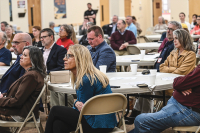African American Project lead reflects on 2022, plans for 2023
 The AAESP highlights many experiences, like that of the Davis family (photographed here) recreating in the park in the 1950s. Last year, the AAESP collected an oral history from Ron Davis Sr., whose father, William E. Davis Jr., worked as a butler and prepared his employer’s summer cabin in the historic area known as Millionaires Row in Elkmont. Davis’ time in Smokies inspired him to pursue a fruitful career in forestry. NPS photo
The AAESP highlights many experiences, like that of the Davis family (photographed here) recreating in the park in the 1950s. Last year, the AAESP collected an oral history from Ron Davis Sr., whose father, William E. Davis Jr., worked as a butler and prepared his employer’s summer cabin in the historic area known as Millionaires Row in Elkmont. Davis’ time in Smokies inspired him to pursue a fruitful career in forestry. NPS photo
Who were they? How did they get here? What were their lives like? These are questions that constantly resonate with me when I gaze upon clouds and mountains and dare to consider the 9,000 years of human history that lie untold within this region that we call home.
Often left out of the popular modern narratives about the Smokies that captivate visitors and locals alike are tales of the African Americans who have made their homes here since the 1500s. To learn about some of them, Great Smoky Mountains National Park is using ground-penetrating radar in the park’s five known cemeteries that contain Black burials — Meigs Mountain, Ravensford, Higdon, Kerr and the Enloe Enslaved Cemetery. Their data reveal definitively that Black people have lived in this region for a long time and that slavery was indeed present in the Smokies.
The African American Experiences in the Smokies Project is an ongoing effort to uncover and share previously untold stories of Black life in the park and its surrounding lands. Leading the charge to document and educate the public about local Black history is Antoine Fletcher, also the park’s science communicator, who says last year marked several milestones for the AAESP.
“The park was able to reach over 500 visitors in-person and virtually last year, telling and asking for African American stories,” he said. “We conducted programs for local universities, for regional NAACP branches, and for internal staff. We look to add to these numbers next year.”

- Science Communicator Antoine Fletcher (right) leads a presentation on the history of the Elkmont area for a group from the National Parks Conservation Association. NPS photo
In 2022, Fletcher and the team updated the AAESP web page on nps.gov with new stories and added historic photos as well as several oral histories to the park archives. They also created and conducted a census records education program to help students understand African American history and worked with the University of Tennessee-Knoxville to hire two African American artists to create illustrations that support stories tied to the project.
Related Items
“I love the research,” Fletcher said. “It is very similar to being a detective in that you have to put pieces together to create a story. As a park, it is our duty to tell these stories, and as a team, we do it very well.”
With the help of last year’s AAESP intern, Atalaya Dorfield, the team was able to secure $97,700 in funding to help create a five-minute movie, update exhibits and offer cultural demonstrations during 2023. They also worked with stakeholders in the community to create wayside panels interpreting themes at relevant locations throughout the park. A panel on Job Conservation Corps history will be placed at Great Smoky Mountains Institute at Tremont, and Mingus Mill will feature two new panels sharing information about the Black Mingus family and the nearby Enloe Enslaved Cemetery. A panel on Daniel White, “The Blackalachian” thru-hiker, is slated for the Newfound Gap area, while Elkmont will soon be home to a new panel sharing the story of the Davis family.
“We will be hiring an intern in March to help with the research,” Fletcher said. “They will focus their efforts on Elkmont’s history but also will be in the park daily to conduct informal pop-up programming.”
Fletcher says there are plans to host an African American bluegrass and country music concert at the Oconaluftee Visitor Center this spring or summer and possibly a spoken-word and music concert at Elkmont in 2024.
Also in 2023, plans are underway to transcribe more oral histories and create an engaging story map for the website that will host videos and new information as it is being discovered.
“The hardest part of telling these stories is that you are dealing with a group of people that was overlooked for a long time, which creates these vast voids when it comes to their history in the region,” he said. “You can research a story for a long time, only to come to a dead end after months of hard work — but that only drives the park to continue this hard work because we know that that void will be filled one day.”

- Geologist Blair Tormey (below) uses ground-penetrating radar at Enloe Enslaved Cemetery near Mingus Mill in Great Smoky Mountains National Park. Ground-penetrating radar technology can reveal details of burial sites 8 to 10 feet underground without disturbing soil or remains. However, the Smokies’ clay-rich wet soils only allow penetration down to about 6 feet. NPS photo
If anyone has oral histories of African Americans or pertaining to the African American story in the Smokies, Fletcher wants to hear from them.
“People can get involved by volunteering their time to help us discover new information,” he said. “Some people become involved by simply supplying information to us or conducting oral histories with us. Soon we will be working on Forgotten Voices, an oral history project that will be accessible through our website. If regional African Americans would like to share their voices with our oral history project, that would be great.”
Antoine Fletcher may be reached at antoine_fletcher@nps.gov. Read more at nps.gov/grsm/learn/historyculture/african-american-experiences-in-the-smokies-project.htm.
Frances Figart (rhymes with Tiger) is the editor of Smokies Life and the Creative Services Director for the 29,000-member Great Smoky Mountains Association, an educational nonprofit partner of Great Smoky Mountains National Park. Reach her at frances@gsmassoc.org.









